Go to see parts 1, 2, 3, 4, and 5.
52) The Who, I Can See for Miles: Sure, it's the power ballads like Love Reign O'er Me or Behind Blue Eyes that provide the meatiest carrion still picked over by industrial radio as well as served as progenitors for countless lesser power ballads to follow, but this nugget from '67 was the first Who song to boll weevil its way into my brain's deep cotton. Maybe it was the otherworldly guilt-tripping subject matter that sent my young mind a-reeling. Add to that Moon's superbly chaotic drumming, Townsend's wailing guitar chorus lines, Daltrey's perfectly attenuated vocal, and a hundred other things that all unfold into the brain pan like a magical musical burrito.
54) It's the Talk of the Town, Glen Gray and the Casaloma Orchestra (1942): My aforementioned Swing Era dad (R.I.P.) dug the Casaloma. I first heard this as a kid and it stuck to me like bacteria on a rock traveling from Mars. This was AM pop (it charted at #6) when ice wagons and rag men worked the streets and white people thought black face was funny. Sure, the lyric is waist high in saccharin sap and melodramatic cheese ("everybody knows you left me, it's the talk of the town") but the pathetic on-point delivery nails it all together in its ball-broken all male chorus. The melody is an ear worm of anaconda proportions and unless you're a heartless psychopath it should infect you like a dose of that Martian bacteria. Plus, this song appeals to all my many overwrought romantic notions about the era, when old maids were 26 year old virgins and men wore ties and fedoras and not sneakers and ball caps. The Talk of the Town is a banjo-driven sentimental journey down a heartsick tunnel to where life was harsher and the military was compulsory. You can thank your lucky stars it's a tunnel where you'll never have to live.
56) Howling Wolf: We know that Blues is the uterus that sprung it all—its umbilical reaching back to both Africa and the vagabond troubadours of Europe—and Wolf owned it. I dig Muddy and Fred McDowell and Son House and Robert Johnson, et al, too, but if Wolf was a baller he would've had the best stats of anyone. Usually, I could give two hoots for purity––Janis, Jimi, The Yardbirds, Zep, Ten Years After, they were all cool too––but Wolf's blues is the purest 28 karat stuff there is. His voice is archetypal, his rhythms the prototype of sleazy stomp, and this dirty geezer knew how to ring the artful smut out of an entendre: No one ever moaned over the I-IV-V better.
58) The Rolling Stones, Sympathy for the Devil, live version from Get Yer Ya-Yas Out: "The Greatest Rock and Roll Band" (see my explanation of all of that here) put their magnum opus on a rhythm rack to see what could be tortured out of it. Keith plays his Chuck Berry chords fatter than Professor Klump and takes the first solo; Mick Taylor glides on the smooth bottom rhythm and takes his noodle turn second. Where Keith's solo sounds drowsy with medication, Mick's is a belly full of anti-depressants. Jagger supports with rooster yelps letting us not forget who rules the roost here. The needle through it all is Charlie who shuffles the beat as hard as Mohammed Ali. I particularly love his kinetic cymbalism toward the end that allows the collective energy to throw off some serious lightening. Here, the Devil gets his due.
59) The 5th Dimension, The Age of Aquarius: Sure, the 5th Dimension are your parents (or grandparents) Easy Listening but it's also pop of the highest order. Their sessions were loaded with legendary players, the vocal arrangements sophisticated, and those songs––damn, were they jolly and infectious. Homecoming queen prim lead singer Marilyn McCoo might've come off like a girl with an aspirin between her legs but boy if she didn't wrap her lips around a melody. On Aquarius the harmonies go orchestral and the group reveals a secret weapon never used before or again: Billy Davis Jr's testifying, crotch scraping shrieks. In the "Let the Sun Shine In" section the dude drops some hard chops. He may be no Otis but he does unleash a series of screams jagged enough to shrink even Wilson Pickett's man sack. And damn if we couldn't use some of the song's cock-eyed hippie mush about now: This should be every goggly optimist's theme song.









.jpg)











